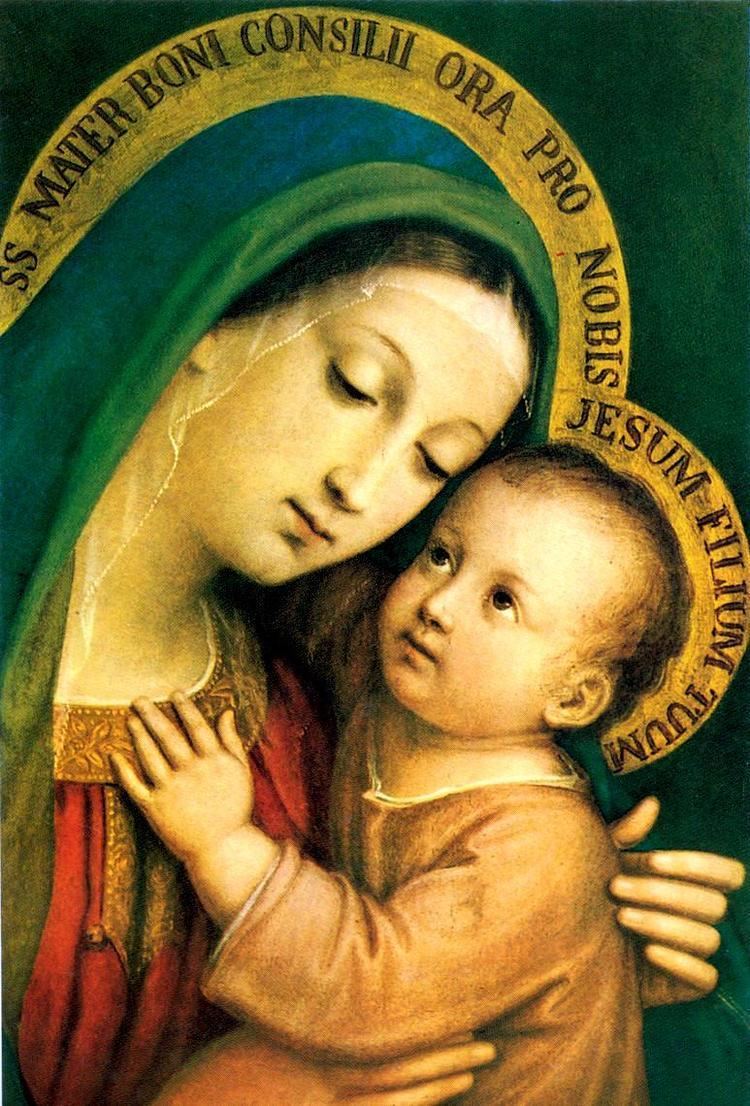 | ||
Mary is known by many different titles (Blessed Mother, Madonna, Our Lady), epithets (Star of the Sea, Queen of Heaven, Cause of Our Joy), invocations (Theotokos, Panagia, Mother of Mercy) and other names (Our Lady of Loreto, Our Lady of Guadalupe).
Contents
- Historical and cultural context
- Dogmatic titles
- Early titles of Mary
- Papal actions
- Devotional titles
- Titles associated with devotional images
- Latin America
- Titles in the Orthodox Church
- Titles of Mary in Islam
- References
All of these titles refer to the same individual named Mary, the mother of Jesus Christ (in the New Testament) and are used variably by Roman Catholics, Eastern Orthodox, Oriental Orthodox, and some Anglicans. (Note: Mary Magdalene, Mary of Clopas, and Mary Salome are different individuals from Mary, mother of Jesus.)
Many of the titles given to Mary are dogmatic in nature. Other titles are poetic or allegorical and have lesser or no canonical status, but which form part of popular piety, with varying degrees of acceptance by the clergy. Yet more titles refer to depictions of Mary in the history of art.
Historical and cultural context
There are several stories on the significance of the relatively large number of titles given to Mary. Some titles grew due to geographic and cultural reasons, e.g. through the veneration of specific icons. Others were related to Marian apparitions.
Mary's help is sought for a large spectrum of human needs in varied situations. This led to the formulation of many of her titles (good counsel, help of the sick, etc.). Moreover, meditations and devotions on the different aspects of the Virgin Mary's role within the life of Jesus led to additional titles such as Our Lady of Sorrows. Still further titles have been derived from dogmas and doctrines, such as the Immaculate Conception.
Mary's cultus or "devotional cult" consolidated in the year 431 when, at the Council of Ephesus, the Theotokos, or Mary as bearer (or mother) of God, was declared dogma. Henceforth Marian devotion—which centered on the subtle and complex relationship between Mary, Jesus, and the Church—would flourish, first in the East and later in the West.
The Reformation diminished Mary's role in many parts of Northern Europe in the 16th and 17th centuries. The Council of Trent and Counter Reformation would intensify Marian devotion in the West. Around the same period, Mary would become an instrument of evangelization in the Americas and parts of Asia and Africa, e.g. via the apparitions at Our Lady of Guadalupe which resulted in a large number of conversions to Christianity in Mexico.
Following the Reformation, as of the 17th century, the baroque literature on Mary experienced unforeseen growth with over 500 pages of Mariological writings during the 17th century alone. During the Age of Enlightenment, the emphasis on scientific progress and rationalism put Catholic theology and Mariology often on the defensive in the later parts of the 18th century, to the extent that books such as The Glories of Mary (by Alphonsus Liguori) were written in defense of Mariology.
Dogmatic titles
Early titles of Mary
“Our Lady” is a common title to give to Mary as a sign of respect and honor. In French she is called "Notre Dame" and in Spanish she is "Nuestra Señora".
Papal actions
Devotional titles
In the Loreto Litanies Mary's prayers are invoked under more than fifty separate titles, such as "Mother Most Pure", "Virgin Most Prudent", and "Cause of Our Joy".
Other devotional titles include:
Titles associated with devotional images
Other titles related to images include:
Latin America
A number of titles of Mary found in Latin America pertain to cultic images of her represented in iconography identified with a particular already existent title adapted to a particular place. Our Lady of Luján in Argentina refers to a small terracotta image made in Brazil and sent to Argentina in May, 1630. Its appearance seems to have been inspired by Murillo's Immaculates. Our Lady of Copacabana (Bolivia): is a figure related to devotion to Mary under the title "Most Blessed Virgin de la Candelaria, Our Lady of Copacabana". About four feet in height, the statue was made by Francisco Tito Yupanqui around 1583 and is garbed in the colors and dress of an Inca princess.
Titles in the Orthodox Church
Theotokos means "God-bearer" and is translated as "Mother of God". This title was given to Mary at the Third Ecumenical Council in Ephesus in 431 AD.(cf. Luke 1:43).
Titles of Mary in Islam
The Qur'an refers to Mary (Arabic: مريم , translit. Maryām) by the following titles:
